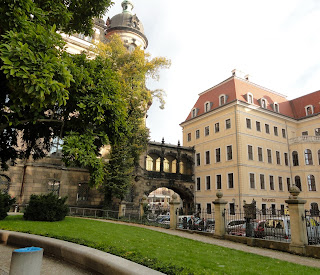Dresden, the city that is recreating itself in its former image after being destroyed during World War II, also takes credit for being the inventive home of the brassiere, filter cigarette and tea bags.
My introduction to the city was a special concert in the beloved Frauenkirche, a pastel and gold swirling froth of Baroque energy where much of the city's restoration was centered.
It was the first night of the annual convention of the Society of American Travel Writers and not only were we treated to a concert, we were allowed to photograph the interior.
Visitors hear much about Frauenkirche and its destruction in the final days of the war. According to our guides, while the church itself was not hit by a bomb, the buildings of the surrounding square were and the heat from the fires caused the dome to collapse. To Dresden residents it was their heart, the most important part of the city that needed to be restored. More than 100,000 individuals contributed to it.
The cross that originally topped the dome was damaged but found. You can see it inside the church. The cross there now was created and donated by the son of the Englishman who piloted the bomber that dropped the bombs causing the square and the church's destruction.
Tip: Unless you climb to the top of the dome, the only steps you'll have to contend with are those from the square up to the church.
Every time someone talks about the city's destruction, credit is given to "the rubble ladies," the many women who gathered and saved the remains because most of the city's men were either dead or in prison.
Restoration stories abound. A Russian officer who loved Baroque architecture forced the Germans to start rebuilding the royal palace immediately. During the bombing its basement was a refuge, then a storage place for potatoes and a "farm" for growing mushrooms.
At war's end, a local architect talked the Russians out of blowing up the damaged Opera House when he arrived one night with three bottles of vodka. By the last drop, the Russians had decided to rebuild it instead.
Augustus the Strong's seat of power and palace, one of 23 he built in Saxony, and its the Zwinger, festivity park, is one of the city's scenic cornerstones. Not only does it give us an image of that royal era, it houses the state's collection of Old Masters, its Meissen (second only to the collection at Topkapi in Istanbul), armory, maps and globes, its awesome Turkish pavilion and the fabled collection of precious materials and jewelry in the famous Green Vault.
We were treated to a Baroque concert and costumed display of royal dancing which anyone can order - all it takes is money. It really is fun to watch and our group of travel writers was far outnumbered by delighted tourists.
As you approach the palace from Frauenkirche, don't miss the only Renaissance-style building left, Kurfuerstich Reissiger Stall, formerly the royal stables and yard designed for knightly training and tournaments. Along its street side is the striking Procession of Princes where all of Saxony's rulers are portrayed in 25,000 tiles from the Meissen Porcelain Manufactory.
Talk about being well located! The arch connecting one section of the palace with a building, Taschenberg Palace, outside the inner complex was built by Augustus the Strong to the house in which he deposited his favorite mistress. Today her palace is a Kempenski Hotel.
The other scenic cornerstone is the Elbe River that flows through Dresden.
Nine historic paddle wheelers ply its waters offering short tours or excursions along 14 stops in an 80-kilometer stretch.
Our short excursion took us from Dresden's center, along high banks of vineyards and beautiful homes to just beyond the Blue Wonder, the only bridge to survive the war. The food was good, too.
Warning: These craft are antiques and do not have lifts or handicapped bathrooms. However the stairs up to the top deck aren't bad and crew is eager to help if the river's water level is such that you need help getting on or off.
In between all of this is a charming, bustling city that I didn't have nearly enough time to see because the convention was split between Dresden and Leipzig. Sigh. Add one more gotta-go-back to the ever-growing list.
Tip: Because of its charm a lot of meetings and conventions are held in Dresden, many at the well-equipped but less than charming for Levelers ICD, International Congress Center. If you are attending a session there, be warned the building is one stairway after another and the elevators are not easy to find. Instead of climbing the stairs to enter, look for the blue and white handicap sign on the north side of the building. Inside the door underneath it and immediately to your right is a small elevator. Take it to the third floor. There will be the coat check and bar to your left; another elevator is ahead of you on the right.
Are there any convention cities you have tips for? Let me know and I'll include you and your tips here.
Friday, January 14, 2011
Subscribe to:
Post Comments (Atom)



















0 comments:
Post a Comment